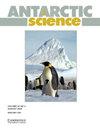Can classic biological invasion hypotheses be applied to reported cases of non-native terrestrial species in the Maritime Antarctic?
IF 2
4区 地球科学
Q3 ENVIRONMENTAL SCIENCES
引用次数: 4
Abstract
Abstract Understanding the success factors underlying each step in the process of biological invasion provides a robust foundation upon which to develop appropriate biosecurity measures. Insights into the processes occurring can be gained through clarifying the circumstances applying to non-native species that have arrived, established and, in some cases, successfully spread in terrestrial Antarctica. To date, examples include a small number of vascular plants and a greater diversity of invertebrates (including Diptera, Collembola, Acari and Oligochaeta), which share features of pre-adaptation to the environmental stresses experienced in Antarctica. In this synthesis, we examine multiple classic invasion science hypotheses that are widely considered to have relevance in invasion ecology and assess their utility in understanding the different invasion histories so far documented in the continent. All of these existing hypotheses appear relevant to some degree in explaining invasion processes in Antarctica. They are also relevant in understanding failed invasions and identifying barriers to invasion. However, the limited number of cases currently available constrains the possibility of establishing patterns and processes. To conclude, we discuss several new and emerging confirmatory methods as relevant tools to test and compare these hypotheses given the availability of appropriate sample sizes in the future.经典的生物入侵假说能否适用于已报道的南极海洋非本地陆生物种的案例?
摘要了解生物入侵过程中每一步的成功因素,为制定适当的生物安全措施提供了坚实的基础。通过澄清适用于已经抵达、建立并在某些情况下成功传播到南极洲陆地的非本土物种的情况,可以深入了解发生的过程。迄今为止,例子包括少数维管植物和更大多样性的无脊椎动物(包括双翅目、弹尾目、Acari和寡毛目),它们具有对南极洲经历的环境压力预先适应的特征。在这篇综述中,我们研究了被广泛认为与入侵生态学相关的多个经典入侵科学假设,并评估了它们在理解迄今为止在非洲大陆记录的不同入侵历史方面的效用。所有这些现有的假设似乎在一定程度上与解释南极入侵过程有关。它们在理解失败的入侵和识别入侵障碍方面也很重要。然而,目前可用的案例数量有限,限制了建立模式和程序的可能性。最后,我们讨论了几种新出现的验证性方法,作为测试和比较这些假设的相关工具,考虑到未来合适的样本量。
本文章由计算机程序翻译,如有差异,请以英文原文为准。
求助全文
约1分钟内获得全文
求助全文
来源期刊

Antarctic Science
地学-地球科学综合
CiteScore
3.60
自引率
6.20%
发文量
42
审稿时长
3 months
期刊介绍:
Antarctic Science provides a truly international forum for the broad spread of studies that increasingly characterise scientific research in the Antarctic. Whilst emphasising interdisciplinary work, the journal publishes papers from environmental management to biodiversity, from volcanoes to icebergs, and from oceanography to the upper atmosphere. No other journal covers such a wide range of Antarctic scientific studies. The journal attracts papers from all countries currently undertaking Antarctic research. It publishes both review and data papers with no limits on length, two-page short notes on technical developments and recent discoveries, and book reviews. These, together with an editorial discussing broader aspects of science, provide a rich and varied mixture of items to interest researchers in all areas of science. There are no page charges, or charges for colour, to authors publishing in the Journal. One issue each year is normally devoted to a specific theme or papers from a major meeting.
 求助内容:
求助内容: 应助结果提醒方式:
应助结果提醒方式:


